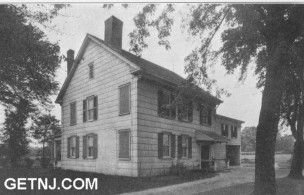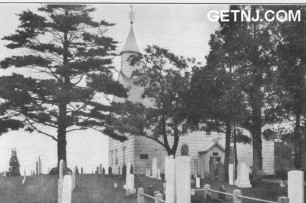 |  |  |
|
| ||
 |  |  |
 |  |  |
|
| ||
 |  |  |
|
|
From Historic Roadsides of New Jersey by The Society of Colonial Wars in the State of New Jersey, 1928
Edited by GET NJ, COPYRIGHT 2002
Freehold and vicinity settled mainly by Scotch. The town
originally called Topanemus, had its origin in the building of a
Court House in 1715 when it became the County Seat.
Notable places:
ENGLISHTOWN
MIDDLETOWN
On the Main Street, nearly opposite the Baptist Church,
is an old burying ground known as the Presbyterian Yard, the
oldest grave being that of John Boune, died 1715.
FRENEAU
Point of interest:
GRAVELLY POINT
SANDY HOOK
COLT'S NECK
SHREWSBURY
Monmouth County, created by Act of Assembly held
at Elizabethtown March 7, 1683, and named by Colonel Lewis
Morris after the place of his nativity, Monmouthshire, Wales,
was first settled by English from Gravesend, Long Island. In
1685 the Dunnottar Castle prisoners, imprisoned by Charles II
for opposition to Established Church, sailed in the Caledonia
with George Scot, Laird of Pitlochie, September 5, 1685. They
stranded on the Jersey Coast December, 1685. Many of them
settled near the Old Scot's (now Tennent) Church. They
were followed a few years later by Dutch from Long Island
and about 1700 a number of French Huguenots settled in the
county. The boundaries of the county first roughly defined in
1675 and definitely settled in 1714, remained as established in
1714 until 1850, when Ocean County was established from it.


FREEHOLD
(or Monmouth Court House) About 30 miles
from Trenton. County Courts held here 1735. Scene of Battle
of Monmouth June 28, 1778, between Clinton's Army retreat
ing from Philadelphia and the Continental Army under Wash,
ington in pursuit.
ADELPHIA
(formerly Blue Ball) About three and one-half
miles south of the Court House in Freehold. At a short distance north of the hamlet is Shumar's or Morgan's Mill. There
Colonel Daniel Morgan with his corps of riflemen waited during the whole of the day of June 28, 1778, for orders to take
part in the Battle of Monmouth. The Bethesda Methodist
Church at Blue Ball, founded about 1780, is the oldest Methodist Church in the State. Present church built in 1849.
MARLBORO on road from Freehold to Bradevelt. The Old
Brick Church-known as the Reformed Church of Navasink
and afterwards as the Dutch Reformed Church dates to days of
the earliest Dutch settlements; was organized about 1699.
Present building erected 1826.
Birthplace of General David Forman,
Commander of the Jersey Troops at Germantown, friend of
Washington, Judge of the County Court, and Member of the
Council of the State. Village House erected in 1732. It was
here orders were framed for the court martial of General
Charles Lee.
Sixteen miles northeast of Freehold. Middletown, a settlement made by men from Gravesend, Long
Island, in 1665, was originally a Baptist settlement. The
church, organized about 1668, was the first Baptist Church in
the State. The first building was torn down in 1734, and
another constructed, which was succeeded by the present
church in 1832.
(once called Mt. Pleasant)
MATAWAN
Burrows Mansion still standing in the village,
erected in the first half of the eighteenth century. Tradition
says, the first New Jersey company formed for the Revolu
tionary War was mustered in the garden, marching to Long
Island to join the army of Washington.
One mile north of Beacon Hill. Spot
where British embarked for New York after the. Battle of
Monmouth, also scene of the murder of Captain Joshua
Huddy.
First lighthouse built 1762. Seized and
fortified by British. Attacked by Monmouth County Militia
under General Forman.
Five miles from Freehold, on a neck of
land formed by two branches of Swimming River. Home of
Joshua Huddy, whose house at Colt's Neck was attacked in
1780 by a party of Loyalists commanded by one Tye, a
mulatto. Huddy, who was captured at the defense of Tom's
River, March 1782, was carried to New York and executed
April 12, 1782, by the Loyalists. He was buried at Freehold
with the honors of war. For this "barbarous outrage against
humanity" the Board of Loyalists was forbidden to remove any
further prisoners and was abolished by Sir Guy Carleton.
Settled by emigrants from Connecticut
1664. Episcopal Church established about 1702, chartered
June 3, 1738. Friends Meeting House, established prior to
1672, visited by George Fox, George Heath, and others.
Original Meeting House now in possession of the Hicksite
Branch of the Society, the Orthodox Friends having built a
new Meeting House at the time of the separation.
Presbyterian Church founded about 1735. Chartered
1749 in connection with Freehold and Allentown.
|
The Historic Roadsides in New Jersey Table of Contents |
|


|
UrbanTimes.com |